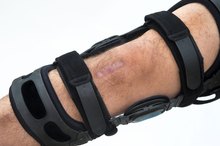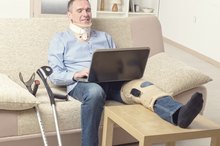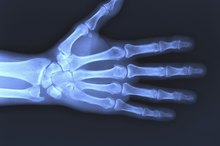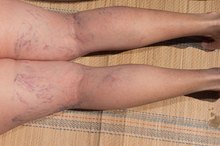Complications From Arthroscopic Knee Surgery
Arthroscopic knee surgery is a procedure in which a surgeon views the interior of the knee joint with a small camera. Viewing the internal knee structure using this minimally invasive procedure can help a surgeon correctly identify and treat knee joint problems. Throughout the world, 4 million arthroscopic knee surgeries are performed each year, according to the American Orthopaedic Society for Sports Medicine 1. Patients should discuss the potential complications from arthroscopic knee surgery with their doctor or surgeon before undergoing this procedure.
If you are experiencing serious medical symptoms, seek emergency treatment immediately.
Blood Accumulation
Rarely, patients who undergo arthroscopic knee surgery can experience unusual blood accumulation within the knee joint, explain medical professionals with the University of Maryland Medical Center. If this occurs, an affected patient may require additional medical intervention to remove the excess blood.
Knee Infection
Most Common Side Effects After Hip Replacement Surgery
Learn More
Arthroscopic knee surgery can increase a patient's risk of developing a knee infection. The infection can develop along the skin at the incision site or within the knee joint itself. Knee infections after arthroscopic knee surgery affects 1 in 250 people, according to health professionals at CartilageDoc.org. Patients who develop symptoms of infection, such as fever or chills, should seek additional medical care as soon as possible.
- Arthroscopic knee surgery can increase a patient's risk of developing a knee infection.
- The infection can develop along the skin at the incision site or within the knee joint itself.
Blood Clots
Infrequently, patients can develop blood clots within the knee after arthroscopic knee surgery, according to University of Washington medical professionals. This complication can cause symptoms of numbness or tingling within the affected knee or leg. Blood clots can result in life-threatening complications if they break loose from the knee and travel into a patient's heart or lungs.
- Infrequently, patients can develop blood clots within the knee after arthroscopic knee surgery, according to University of Washington medical professionals.
- Blood clots can result in life-threatening complications if they break loose from the knee and travel into a patient's heart or lungs.
Nerve, Ligament or Vessel Injury
Complications After Partial Knee Replacement
Learn More
During surgery, the nerves, ligaments or blood vessels within the knee can be inadvertently damaged, according to CartilageDoc.org. Though such complications are rare, they can cause permanent knee or lower leg numbness or movement difficulties. Patients who develop unusual pain or tingling following arthroscopic knee surgery should consult a medical professional immediately.
- During surgery, the nerves, ligaments or blood vessels within the knee can be inadvertently damaged, according to CartilageDoc.org.
- Though such complications are rare, they can cause permanent knee or lower leg numbness or movement difficulties.
Stiffness, Swelling, Bruising or Pain
Common complications from arthroscopic knee surgery include knee stiffness, swelling, bruising or pain. These surgical complications are temporary and typically subside as the knee begins to heal postsurgery. Physical therapy can help relieve knee stiffness and restore a patient's normal range of motion. Doctors typically recommend applying ice to the knee and taking specific pain medication to help alleviate uncomfortable knee swelling or pain. Bruising can cause temporary skin discoloration around the site of the knee incisions. Affected patients can notice that the discolored skin regions are tender to the touch. Patients can use crutches temporarily to avoid placing excess weight on the affected knee.
- Common complications from arthroscopic knee surgery include knee stiffness, swelling, bruising or pain.
- Doctors typically recommend applying ice to the knee and taking specific pain medication to help alleviate uncomfortable knee swelling or pain.
Related Articles
References
- American Academy of Orthopaedic Surgeons: Knee Arthroscopy
- CartilageDoc.org: Dr. Cole's Knee Arthroscopy Consent - Possible Complications
- Salzler MJ, Lin A, Miller CD, Herold S, Irrgang JJ, Harner CD. Complications after arthroscopic knee surgery. Am J Sports Med. 2014;42(2):292-6. doi:10.1177/0363546513510677
- American Academy of Orthopaedic Surgeons. Knee arthroscopy. September 2016.
- University Hospitals Plymouth NHS Trust. Recovering from an arthroscopy.
- Ghani H, Maffulli N, Khanduja V. Management of stiffness following total knee arthroplasty: a systematic review. Knee. 2012;19(6):751-9. doi:10.1016/j.knee.2012.02.010
- Di caprio F, Meringolo R, Navarra MA, Mosca M, Ponziani L. Postarthroscopy osteonecrosis of the knee: current concepts. Joints. 2017;5(4):229-236. doi:10.1055/s-0037-1608666
- Friberger pajalic K, Turkiewicz A, Englund M. Update on the risks of complications after knee arthroscopy. BMC Musculoskelet Disord. 2018;19(1):179. doi:10.1186/s12891-018-2102-y
- Balato G, Di donato SL, Ascione T, et al. Knee septic arthritis after arthroscopy: incidence, risk factors, functional outcome, and infection eradication rate. Joints. 2017;5(2):107-113. doi:10.1055/s-0037-1603901
- Flevas DA, Megaloikonomos PD, Dimopoulos L, Mitsiokapa E, Koulouvaris P, Mavrogenis AF. Thromboembolism prophylaxis in orthopaedics: an update. EFORT Open Rev. 2018;3(4):136-148. doi:10.1302/2058-5241.3.170018
- Martin CT, Pugely AJ, Gao Y, Wolf BR. Risk factors for thirty-day morbidity and mortality following knee arthroscopy: a review of 12,271 patients from the national surgical quality improvement program database. J Bone Joint Surg Am. 2013;95(14):e98 1-10. doi:10.2106/JBJS.L.01440
Writer Bio
Rae Uddin has worked as a freelance writer and editor since 2004. She specializes in scientific journalism and medical and technical writing. Her work has appeared in various online publications. Uddin earned her Master of Science in integrated biomedical sciences with an emphasis in molecular and cellular biochemistry from the University of Kentucky College of Medicine.









